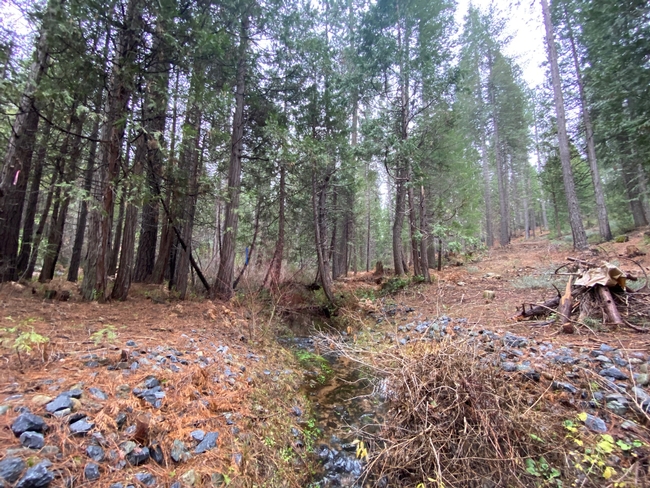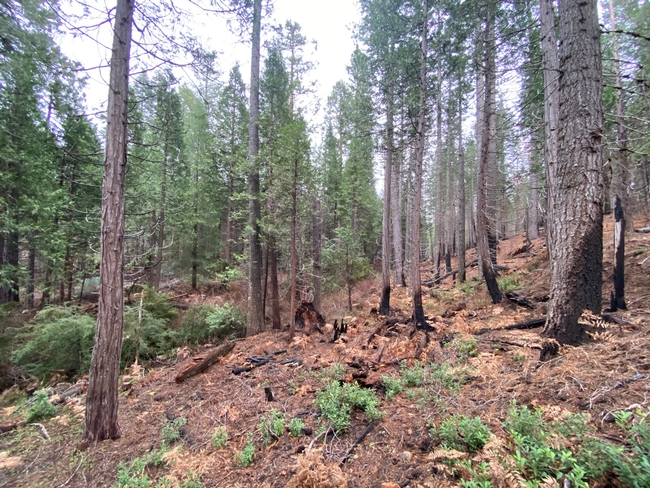There is increasing concern about fire hazard from fuels accumulation in riparian areas and what forest landowners can do to manage these areas. Riparian vegetation and forests have ecological importance in terms of water quality and quantity, and wildlife and aquatic habitat. They also have social value such as recreation, natural heritage and aesthetics. These values are important to forest landowners, but is it possible to balance protection of riparian areas with fire hazard reduction?
Historical fire in riparian areas. In the last decade,we've come to better understand fire regimes in riparian areas. Research by Van de Water and North (2011) found that riparian and upland Sierran mixed conifer forests had similar forest composition, structure, fuel loading and fire behavior under an active fire regime. Before the era of fire suppression, fire burned through riparian areas regularly at varying intensity, thinning out trees and maintaining low amounts of fuels. Coupled with higher soil moisture, the lower vegetation density in riparian areas could disrupt the spread of fire across the landscape and act as a refuge for wildlife. California Native Indian tribes often applied fire in riparian areas to encourage the re-sprouting of tree and shrub species that respond well to low-intensity fire.
What are the current rules for managing riparian areas? Unfortunately, regulations on managing riparian areas have not really caught up to our new understanding of their fire regimes. Under the California Forest Practice Rules, the Watercourse and Lake Protection Zone (WLPZ) defines areas of land along both sides of a creek or stream, or around the circumference of a lake or spring, that buffers riparian areas against soil disturbances that potentially come from heavy equipment. The width of a WLPZ varies between 50 and 150 feet depending on slope, the class of the watercourse, and the geography of the location. Within the WLPZ, percentages of surface cover, canopy cover, and undisturbed areas must be maintained to protect water resources and wildlife habitat. Equipment Exclusion Zones (EEZs) prohibit the use of heavy equipment within the WLPZ in order to prevent soil disturbance, erosion and sedimentation into watercourses. In very small watercourses, you may be allowed some entry with heavy equipment through use of an Equipment Limitation Zones (ELZs) instead of an Equipment Exclusion Zone (EEZ).
Current research. Rob York, UC Cooperative Extension Forestry Specialist at UC Berkeley, Department of Environmental Science, Policy and Management, has been doing research at UC Blodgett Forest Research Station looking at fuels management within riparian areas and the potential to mitigate fire hazard. Rob and his team are evaluating the effectiveness of existing WLPZ regulations, as well as other evidence-based alternatives, that aim to sustain low fire severity and high species diversity in and around riparian Sierra Nevada forests. According to Rob, while the intent of the CA Forest Practice Regulations is to avoid significant adverse cumulative impacts to the beneficial functions of riparian zones, there is an unintended risk of high severity wildfire impacts because of the lack of management done there. Without treatments that are similar in nature to the historic fire regime, riparian areas become more vulnerable to high severity fire.
With current regulations, it has essentially been easier to reduce fire hazard everywhere else besides the riparian area despite their special ecological and social value. An unintended consequence of this can be seen in the 2007 Angora fire, in which the untreated riparian areas acted as a wick for high severity fire along Angora Creek that ultimately led to destruction of over 250 homes.
What is a landowner to do? We now encourage appropriate fuels reduction in riparian areas. That said, it can be hard to do logistically. As heavy equipment is not allowed in riparian areas, trees can sometimes be cut and pulled out using a cable from outside the buffer area (called end lining). Because of this extra cost, however, it can lead to the preferential removal of larger trees which are desirable to retain. Thinning can occur by hand cutting, piling and burning, though in some areas you may be required to pull the burn piles out of the riparian area so ash doesn't reach the watercourse. A landowner could also treat the burn pile area by either covering it or working the ash and debris into the soil. Another option for riparian areas is prescribed fire in the spring or after fall rains begin. Because riparian areas are generally moist during the time of year when prescribed burns are allowed, reducing canopy cover to 60% or less can increase the probability of a successful prescribed fire because the greater radiation input can dry out surface fuels more quickly. Although reducing canopy is allowed under canopy retention rules, it is difficult to accomplish be because of Equipment Exclusion Zones.
For more information and assistance, please contact your local UC Cooperative Extension Forestry and Natural Resources Advisors and Specialists.

